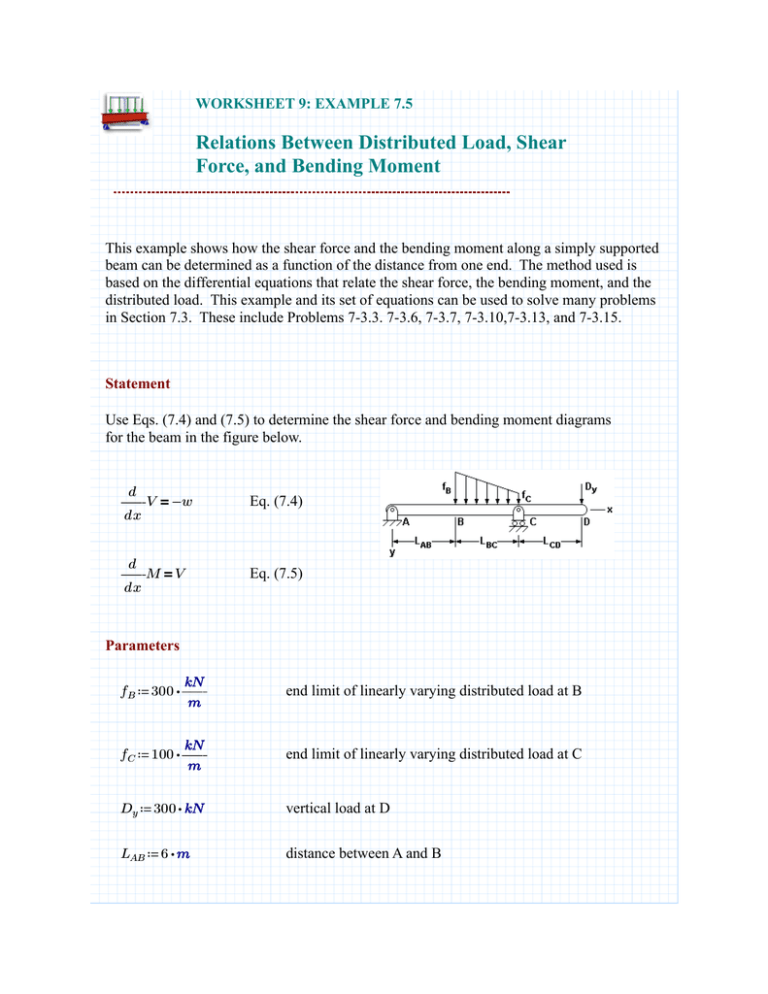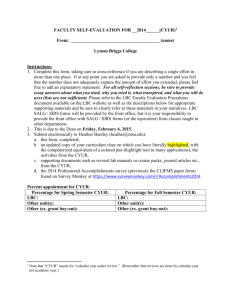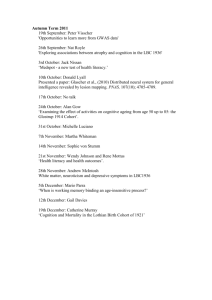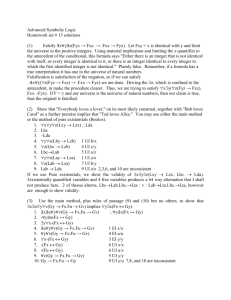Relations Between Distributed Load, Shear Force, and Bending Moment
advertisement

WORKSHEET 9: EXAMPLE 7.5 Relations Between Distributed Load, Shear Force, and Bending Moment This example shows how the shear force and the bending moment along a simply supported beam can be determined as a function of the distance from one end. The method used is based on the differential equations that relate the shear force, the bending moment, and the distributed load. This example and its set of equations can be used to solve many problems in Section 7.3. These include Problems 7-3.3. 7-3.6, 7-3.7, 7-3.10,7-3.13, and 7-3.15. Statement Use Eqs. (7.4) and (7.5) to determine the shear force and bending moment diagrams for the beam in the figure below. d V = −w ―― dx Eq. (7.4) d M=V ―― dx Eq. (7.5) Parameters kN fB ≔ 300 ⋅ ―― m end limit of linearly varying distributed load at B kN fC ≔ 100 ⋅ ―― m end limit of linearly varying distributed load at C Dy ≔ 300 ⋅ kN vertical load at D LAB ≔ 6 ⋅ m distance between A and B LBC ≔ 6 ⋅ m distance between B and C LCD ≔ 6 ⋅ m distance between C and D Solution Equivalent Concentrated Load Representation of Distributed Load We begin by determining the expression of the distributed load w(x) as a function of position x. Since w(x) is a linear function, we can express it in the form w(x) = cx + d, where c and d are constants. We know w at x = LAB and x = LAB + LBC: fB = c ⋅ LAB + d and fC = c ⋅ ⎛⎝LAB + LBC⎞⎠ + d These can be solved simultaneously to give fC − fB c ≔ ――― LBC kN c = −33.333 ―― m2 d ≔ fB − c ⋅ LAB kN d = 500 ―― m Thus, the linearly varying distributed load can be written as w ((x)) ≔ c ⋅ x + d We check here that indeed the function gives the right values at the known limits: kN w ⎛⎝LAB⎞⎠ = 300 ―― m kN w ⎛⎝LAB + LBC⎞⎠ = 100 ―― m To go further, this distributed load can be represented by one resultant force Fd acting at a specific location x = xd, where LAB + LBC Fd ≔ ⌠ w (x) d x ⌡ ( ) Fd = ⎛⎝1.2 ⋅ 10 3⎞⎠ kN LAB LAB + LBC ⌠ x ⋅ w (x) d x ( ) ⌡ LAB xd ≔ ――――― Fd xd = 8.5 m The free-body diagram of the entire beam with the distributed load replaced by the resultant force Fd is shown on the right. We now obtain the reactions Ax, Ay, and Cy from the equilibrium equations. Since Fx = 0, Ax ≔ 0 Since M(point A) =0 ⎛⎝LAB + LBC⎞⎠ ⋅ Cy − xd ⋅ Fd − ⎛⎝LAB + LBC + LCD⎞⎠ ⋅ Dy = 0 ⎛⎝xd ⋅ Fd + Dy ⋅ LAB + Dy ⋅ LBC + Dy ⋅ LCD⎞⎠ Cy ≔ ―――――――――――― ⎛⎝LAB + LBC⎞⎠ Cy = ⎛⎝1.3 ⋅ 10 3⎞⎠ kN Since Fy = 0 Ay + Cy − Fd − Dy = 0 A y ≔ Fd + D y − C y Ay = 200 kN We now proceed to determine the shear force and bending moment as functions of x for the entire beam, using Eqs. (7.4) and (7.5). Shear Force Diagram From A to B There is no load between A and B, so the shear force increases by Ay at A and then remains constant from A to B: VAB ((x)) ≔ Ay From B to C From our solution between A and B, Eq. (7.4) from x = LAB to an arbitrary value of x between B and C: (x)) VBC ( x . Integrating x ⌠ 1 d V = ⌠ −w d x = ⌠ −(c ⋅ x + d) d x ) ⌡ ⌡ ⌡ ( VAB (LAB) LAB LAB we obtain an equation for V between B and C: ⎛ c ⋅ ⎛x 2 − L 2⎞ ⎞ ⎝ AB ⎠ ( ) ⎛ ⎞ VBC (x) ≔ VAB ⎝LAB⎠ − ⎜――――― + d ⋅ ⎛⎝x − LAB⎞⎠⎟ 2 ⎝ ⎠ From C to D At C, V undergoes an increase of due to the force exerted by the pin support. Adding this change to the value of V at C obtained from our solution from B to C, the value of V just to the right of C is VBC ⎛⎝LAB + LBC⎞⎠ + Cy = 300 kN There is no loading between C and D, so V remains constant from C to D: VCD ((x)) ≔ VBC ⎛⎝LAB + LBC⎞⎠ + Cy We combine the results for all three sections using Mathcad's if function: V ((x)) ≔ if ⎛⎝x < LAB , VAB ((x)) , if ⎛⎝x < LAB + LBC , VBC ((x)) , VCD ((x))⎞⎠⎞⎠ The shear force diagram is shown below, after defining a range variable for the distance from the left end: i x ≔ ―― ⋅ ⎛⎝LCD + LAB + LBC⎞⎠ i 300 i ≔ 0 ‥ 300 450 300 150 0 -150 -300 -450 -600 -750 -900 -1.05⋅10³ 0 2 4 6 8 10 12 14 16 LAB + LBC + LCD Bending Moment Diagram From A to B Integrating Eq. (7.5) from x = 0 to an arbitrary value of x between A and B: MAB ( (x)) x x ⌠ 1 d M = ⌠ V (x) d x = ⌠ A d x ⌡ ⌡ AB ( ) ⌡ y 0 0 0 we obtain: MAB ((x)) ≔ Ay ⋅ x MAB ⎛⎝LAB⎞⎠ = ⎛⎝1.2 ⋅ 10 3⎞⎠ kN·m From B to C Integrating Eq. (7.5) from x = LAB to an arbitrary value of x between B and C: MBC ( (x)) x ⌠ 1 d M = ⌠ V (x) d x ⌡ ⌡ BC ( ) MAB (LAB) LAB x ⌠ ⎛ −c ⎛c ⎞⎞ ⎮ ⎜―― ⋅ x 2 − d ⋅ x + ⎜―⋅ LAB + d ⋅ LAB + VAB ⎛⎝LAB⎞⎠⎟⎟ d x ⎝2 ⎠⎠ ⎮ ⌡⎝ 2 LAB we obtain an equation for V between B and C: ⎛c ⎞ −c ⎛ 3 d MBC ((x)) ≔ MAB ⎛⎝LAB⎞⎠ + ―― ⋅ ⎝x − LAB 3⎞⎠ − ―⋅ ⎛⎝x 2 − LAB 2⎞⎠ + ⎜―⋅ LAB 2 + d ⋅ LAB + VAB ⎛⎝LAB⎞⎠⎟ ⋅ ⎛⎝x − LAB⎞⎠ 6 2 ⎝2 ⎠ Note that at x, x:=Lab, MBC ⎛⎝LAB⎞⎠ = ⎛⎝1.2 ⋅ 10 3⎞⎠ kN·m MBC ⎛⎝LAB + LBC⎞⎠ = −1.8 ⋅ 10 3 kN·m From C to D Integrating Eq. (7.5) from x = LAB + LBC to an arbitrary value of x between C and D: MCD ( (x)) x ⌠ 1 d M = ⌠ V (x) d x ⌡ ⌡ CD ( ) MBC (LAB + LBC) LAB + LBC x ⌠ ⎛V ⎛L + L ⎞ + C ⎞ d x BC⎠ y⎠ ⌡ ⎝ BC ⎝ AB LAB + LBC we obtain: MCD ((x)) ≔ MBC ⎛⎝LAB + LBC⎞⎠ + ⎛⎝VBC ⎛⎝LAB + LBC⎞⎠ + Cy⎞⎠ ⋅ ⎛⎝x − LAB − LBC⎞⎠ We combine the results for all three sections: M ((x)) ≔ if ⎛⎝x < LAB , MAB ((x)) , if ⎛⎝x < LAB + LBC , MBC ((x)) , MCD ((x))⎞⎠⎞⎠ The bending moment diagram is shown below: 1.5⋅10³ 1.2⋅10³ 900 600 300 0 -300 -600 -900 -1.2⋅10³ -1.5⋅10³ -1.8⋅10³ 0 2 4 6 8 10 12 14 16 18 Discussion Compare this example with Example 7.3, in which we use free-body diagrams to determine the shear force and bending moment as functions of x for this beam and loading.







